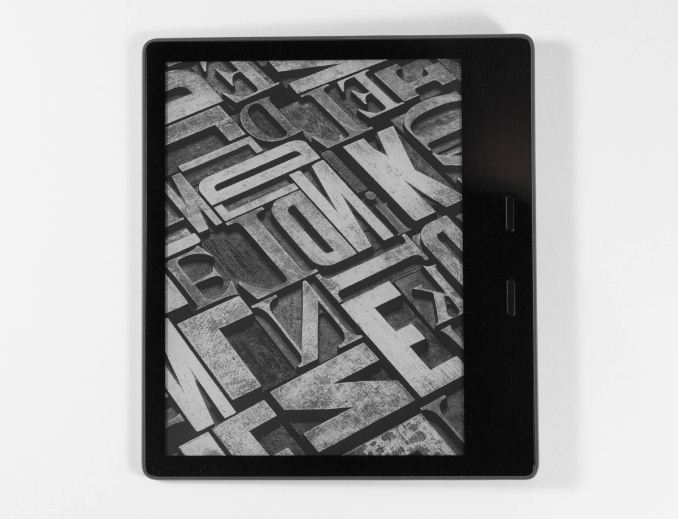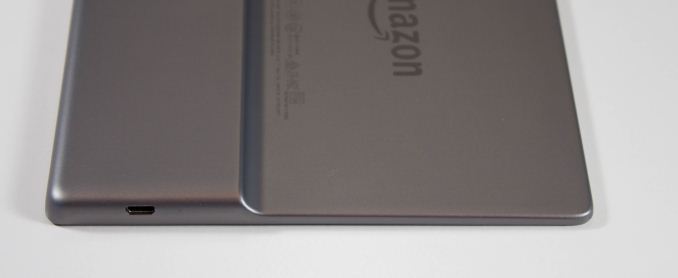The Amazon Kindle Oasis (2017) Review: A Premium Take On The E-Reader
by Brett Howse on January 25, 2018 8:00 AM EST- Posted in
- Accessories
- Amazon
- Kindle
- e-ink
- E-Reader
- Kindle Oasis

A couple of months ago, Amazon released an all-new Kindle Oasis, and I’ve been using it since mid-November. The E-Reader market is a niche inside of a niche, but there’s little doubt that Amazon has been at the forefront of E-Readers since the Kindle first launched. If you’re someone who loves reading, you’ve hopefully had a chance to try reading on an electronic ink display, but if not, maybe this is the time to jump in.
Amazon offers the Kindle lineup for pretty much one reason. Owners of Kindles are almost guaranteed to purchase books from Amazon, and as such, Amazon has done a pretty reasonable job keeping the entry cost into the Kindle lineup fairly low. Right now you can get the lowest cost Kindle for just $79.99, assuming you are ok with Amazon’s “Special Offers” which is advertising from Amazon on your lockscreen. If you don’t want that, the Kindle is $99.99. However, the new Kindle Oasis for 2017 starts at $249.99 with Special Offers, or $269.99 without, so for that much of an increase, Amazon needs to pack in the features. Luckily they did.
The Kindle Oasis doesn’t just need to compete with the base Kindle though. Amazon also offers the Kindle Paperwhite, which is their entry level model with lighting, and the Kindle Voyage, which at one point was at the top of the stack, but now sits below the Oasis in terms of features and pricing. And that’s just the competition with other Kindles.
The 2017 Oasis adds some nice features over it’s cheaper brethren though. The once change that is hard to miss is the larger E Ink display, now at 7-inches diagonal, compared to 6-inches for the other devices. It’s still the same 300 PPI display as offered in both the Paperwhite and the Voyage, but with additional LEDs for a more even lighting. The Oasis is also made out of aluminum, rather than plastic, and is thinner and feels lighter than the other models despite the larger display. It supports Bluetooth for headphones or speakers, which lets you use the device for Audible audiobooks, and for those that like to use their Kindle around water, it’s also IPX8 rated meaning it’s able to be dropped in water and still function.
| Amazon Kindle Lineup | |||||
| Kindle | Paperwhite | Voyage | Oasis | ||
| Display Size | 6-inch | 7-inch | |||
| Resolution | 167 PPI | 300 PPI | |||
| Built-in Light | No | 4 LEDs | 6 LEDs + auto-brightness | 12 LEDs + auto-brightness | |
| SoC | NXP i.MX6SL Cortex A9 @ 1 GHz | NXP i.MX7D dual-core Cortex A7 @ 1 GHz | |||
| Page Turns | Touchscreen | Touchscreen + Buttons | |||
| Colors | Black, White | Black | Graphite, Aluminum back | ||
| Connectivty | Wi-Fi | Wi-Fi plus optional Cellular | |||
| Weight | 161 g / 5.7 oz | Wi-Fi model: 205 g / 6.6 oz Cellular model: 217 g / 7.6 oz |
Wi-Fi model: 180 g / 6.3 oz Cellular model: 188 g / 6.6 oz |
Wi-Fi or Cellular: 194 g / 6.8 oz |
|
| Dimensions | 160 x 115 x 9.1 mm 6.3" x 4.5" x 0.36" |
169 x 117 x 9.1 mm 6.7" x 4.6" x 0.36" |
162 x 115 x 7.6 mm 6.4" x 4.5" x 0.30" |
159 x 141 x 3.4-8.3 mm 6.3" x 5.6" x 0.13-0.33" |
|
| Waterproof | No | IPX8 - 2 meters, 60 minutes | |||
| Audiobook Support | No | Yes with Bluetooth headphones | |||
| Starting Price | $79.99 | $119.99 | $199.99 | $249.99 | |
With the addition of audiobook support, Amazon offers double the storage by default, or you can opt for the 32 GB model for another $30. For those that like the always-connected nature of cellular, Amazon continues to offer cellular enabled devices as well, for a premium. Luckily you don’t have to deal with a data plan if you do get a cellular equipped device, since Amazon covers that for the life of the device.
I’ve been a heavy Kindle user since the 3rd generation Kindle launched back in 2010. The one big issue with the older kindles was the lack of a built-in light, so when the Paperwhite launched in Canada I jumped on it. That model lasted for about four years until the power switch started to fail, so I upgraded to the latest generation of Paperwhite. This review will focus on the Oasis, but with comparisons to the Paperwhite where applicable.
So with a new body, bigger display, and IPX8 rating, does the Kindle Oasis tick all the boxes, and make it the device to get? Let’s dig in and find out.











93 Comments
View All Comments
LeftSide - Thursday, January 25, 2018 - link
Thanks for the review! One of the biggest features I use on my kindle is the OpenDyslexia font. It really helps with my read speeds and accuracy. I have an older kindle with less DPI. I’m thinking 300dpi would help even more to smooth out the fonts. I’ve been looking to replace it soon, and this is the best review I’ve seen so far.PeachNCream - Friday, January 26, 2018 - link
The higher DPI and lighting really helps the reading experience a lot. I had the bottom end Kindle from around 2012 for a long time and had to replace it when my ex took it along to move in with the new girlfriend. I ended up getting a Paperwhite as a replacement and it's been a nice upgrade over the old one, though I feel like the old Kindle had better battery life from the start. Even with the backlight and WiFi turned off, the Paperwhite seems to require a recharge more often than I remember the old Kindle needing when it was new.nico_mach - Monday, January 29, 2018 - link
I like my entry level kindle because without the extra tech, it's the lightest kindle and the best battery life. I ditch my case all the time, making it incredibly light. But my wife loves her paperwhite, she reads in bed in the dark all the time and I get that. Every review says it's essential, but books were never backlit, right?For bedtime reading, I wish the paperwhite etc had a redder light.
mode_13h - Monday, January 29, 2018 - link
Kobo Aura ONE has a nighttime reading mode, for the light.DanNeely - Thursday, January 25, 2018 - link
Nice to see an extended review of a niche device like this. I do enough reading on my current kindle, ~100 novels/year that if/when I need to replace it; I probably will spring for this model.The main counter argument against doing so now are that my old Kindle Keyboard (gen3) still works and still has a reasonable battery life ~2.5-3 down from ~4.5 when new. My reading pattern's bursty enough (I might read 5 in one week and none for the next two or three weeks) that I normally leave the wifi off to avoid finding it dead if I left it off the charger for too long.
A secondary annoyance is that I don't want to keep carrying multiple sets of chargers/cables when on the road. My phone's USB-C, my next laptop will be USB-C powered, and I really don't want to still be carrying a second cable for my Kindle a half dozen years from now because it's still using a micro-B plug. I know it's less of an issue for people who've got a much larger collection of USB powered devices to pack along because they'll have multiple long tail devices on the old standard for a while and probably will want more cables for parallel charging anyway; but the 3 devices I mentioned are all I normally take with me.
erwos - Thursday, January 25, 2018 - link
I flat-out won't buy new electronics over about twenty bucks unless they have USB-C. Micro-B is on the way out and it was never a very durable connector to begin with. Even USB-A is starting to show signs of obsolescence.I don't know why Amazon seems so resistant to USB-C, but they really need to start migrating their product lines to it. I am flat-out not buying a new Kindle or a Fire until I see USB-C on them.
DanNeely - Thursday, January 25, 2018 - link
My suspicion is that it's about cost because almost all Amazon branded electronic products are priced low enough they're at best barely breaking even if not selling them at a small loss to support their stores to the extent that even adding a dollar to the BOM cost is a big deal. I pricechecked on mouser.com (a electronic component supply company), and in bulk quantities (tens of thousands) you can get micro-b connectors for as little as $0.15, vs $0.95 for USB-C sockets. When the Oasis first came out the price premium was higher, IIRC over a dollar.While the Oasis is an exception to Amazon's race to the bottom/loss leader pricing strategy I suspect they hesitate because adding it to one model would increase consumer pressure to add it to the more mass market parts.
I expect the price gap for the newer connectors to continue to narrow as supply increases and the manufacturing companies gradually pay off their capital expenses for the new manufacturing hardware. I'm skeptical that they'll ever get as low as micro-b connectors. This both because the USB-C port is more complex and because phones going USB-C has resulted in a large production excess for micro-B ports. Short of something else replacing USB-C connectors (wireless charging, and wifi/bt only, or a notional USB-D connector some years down the line) we're unlikely to see a massive excess in production capacity pushing down prices through the basement floor.
grant3 - Thursday, January 25, 2018 - link
1. You can find USB-C sockets all over alibaba for under $0.35/ea and some as low as $0.08/ea2. Oasis is the premium Kindle, for $250, even if USB-C costs an extra few cents, this is the appliance that deserves it.
kcladyz - Friday, August 2, 2019 - link
That is stupid to not buy something over a charging port. Amazon charges super fast and it fits many of my other devices such as my NOOK.shonferg - Thursday, January 25, 2018 - link
I have this as well and have really liked it. The one thing that disappointed me about it, though, was that the blacks on my older Paperwhite from 3 or 4 years ago are noticeably darker. The biggest reason I decided to pay for the new device was that they finally increased the screen size, and I thought this, plus the increased resolution and storage space, would make reading manga much better. It is better on balance and worth the upgrade, but the way the pictures look a bit washed out compared to the old model is a bit disappointing. I haven't seen this mentioned in any reviews yet, which makes me wonder if it's just my device or if they are all like this.